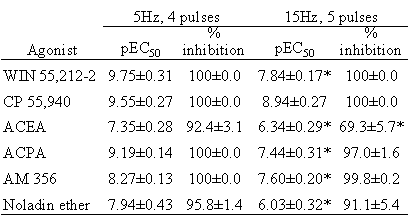| pA2
online © Copyright 2003 The British Pharmacological Society |
044P
University
of Manchester Autumn Meeting September 2003 |
|
The actions
of six cannabinoid agonists in mouse
|
Print Abstract Search PubMed
for: |
Constant current electrical field stimulation (CCFS) causes contractions of mouse isolated vas deferens (MVD) preparations. Stimulation of pre-synaptic cannabinoid CB1 receptors results in a reduction in neurotransmitter release and as a consequence, a reduction in twitch height (Pertwee et al, 1995). In earlier studies, optimal stimulation parameters were determined as: constant current of 400mA, trains of 4 pulses at 5 Hz and pulse duration of 2ms at 10sec intervals between trains (K. McMillan, BPS Poster P66, Sept 2003). Using trains of 5 pulses at 15Hz, a marked decrease in potency was observed using the CB1 agonists WIN 55, 212-2 and ACEA. The aim of this study was to evaluate the potency and efficacy of four additional cannabinoid agonists [ACPA, CP 55,940, methanandamide (AM356), and noladin ether] under two different stimulation conditions.
ICR mice (25-30g) were killed by exposure to CO2. Each vas deferens was removed. Each end was secured with 2/0 siliconised braided sutures and placed in a 10ml bath filled with modified Mg2+-free Krebs Henseleit buffer at 37oC bubbled with 95% O2 and 5% CO2. The sutures were connected to a tissue holder and a Grass isometric force transducer type FT03. The force transducers were connected to a Grass Model C7 cabinet amplifier coupled to an Astromed K2G recorder. Two platinum electrodes were placed parallel to the preparations in the baths for CCFS, using a D330 MultiStim stimulator (Digitimer Ltd, UK).
Each vas deferens was subjected to CCFS for 45 min prior to determining cumulative concentration response curves. Each compound was tested over the concentration range: 10-10 - 10-5M; 0.5 log unit increments; 3 min intervals; 50ml injections. All compounds were obtained from Tocris, UK. The results are summarised in Table 1.
Table 1: Comparison of the potency and efficacy of six cannabinoid agonists in the MVD, under two different stimulation conditions.

All data given are the mean ± s.e.m. n=4 for each compound.* significantly different ( p<0.05) unpaired t-test.
This study demonstrates that small changes in stimulation parameters can have a dramatic effect on the potency of cannabinoid agonists.
CP 55,940 causes inhibition which is not dependent on these stimulation conditions, suggesting that other non-cannabinoid properties might be present.
Pertwee R.G. et al., (1995) Eur. J. Pharmacol., 284, 241-247.